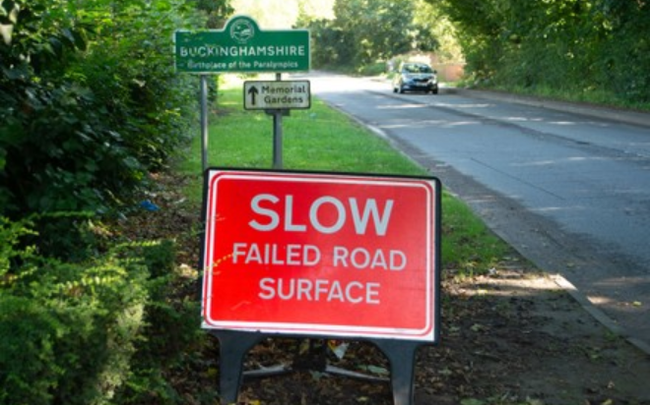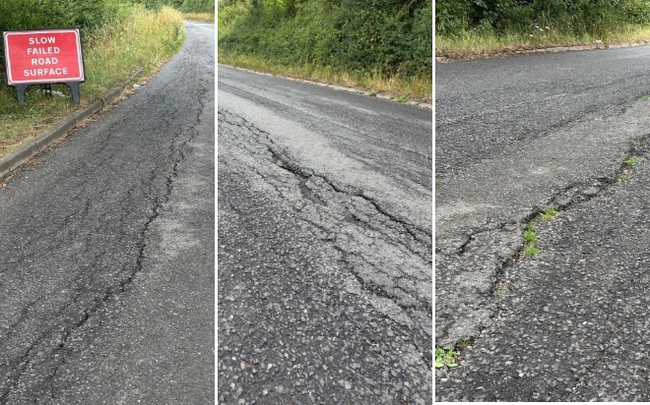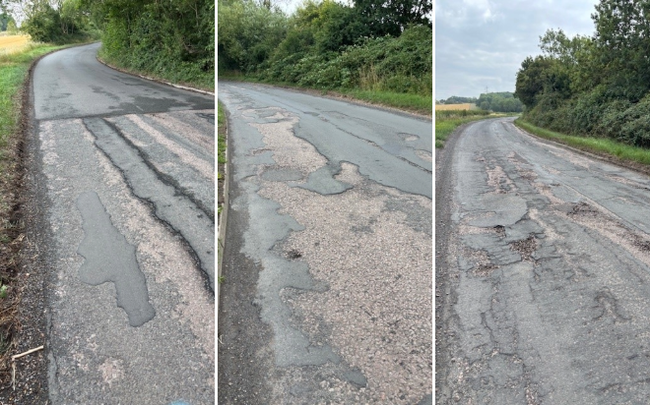On the Road to Recovery - responding to failed roads in Buckinghamshire

We know that our county’s roads remain a very popular topic for those who live and travel into Buckinghamshire. Ongoing pressures such as global inflation, extreme weather and the sustained impact of heavy construction traffic linked to HS2 and East West Rail (EWR) projects contribute to the condition of our roads. This is why it is essential for Buckinghamshire Highways to continue to strategically invest into our roads and prioritise the safety of our road users. We've answered some of the most popular questions about failed roads including the treatment of failed roads and addressed some common misconceptions below.
A failed road refers to a section of highway or carriageway that has deteriorated to the point where it no longer meets acceptable standards. This includes:
Structural failure e.g.
- Alligator cracking - a common type of damage found in asphalt surfaces characterised by a “jigsaw” of cracks that resemble an alligator’s skin.
- Rutting - the formation of permanent “dips” running length-wise in the wheel paths of a surface.
- Potholes that appear quickly between inspections and are often deep.
Surface degradation
- This is when the resulting effect is multiple potholes forming over large areas of a road, not treatable with usual patching techniques.
In Buckinghamshire’s context, a failed road is one that is below a desirable condition and cannot be immediately repaired, often requiring temporary signage and long-term planning for maintenance. Our Highway Safety Inspection Policy provides more information on defect categorisation.
A road is initially identified as “failing” based on:
- Routine safety inspections
- Ad-hoc inspections
- Public or customer reports – please continue to make these via FixMyStreet!
- Condition surveys
Once identified, the road is assessed by a decision-maker (e.g. Network Operations Manager or Asset Manager), and actions are agreed upon. More on this below, under ‘How does Buckinghamshire Highways treat failed roads?’.
Road failure can result from a combination of factors, including:
- Traffic loads - particularly heavy or repetitive traffic.
- Poor drainage and the impact of water – this is most seen in our evolved country lanes* and is made worse with heavy rainfall. A lack of positive drainage allows water to seep into the structure of roads which softens the natural soil or rock on which a road is constructed and causes rutting and the cracking at the edges of the surface.
- Extreme weather, variations in temperature and geology – rising temperatures and the impact of heatwaves (like we’ve recently experienced!) can cause the underlying sediments (natural materials like soil, rock and clay) to expand leading to cracking on the road surface. Similarly, the ‘freeze thaw’ cycle during the winter months can also lead to cracks in the road surface and the formation of potholes. Read more about how potholes are formed.
- Substandard materials or construction – often our evolved country lanes* are little more than cart tracks with very little constructed thickness.
- Aging infrastructure – just like pretty much everything, our roads also see the impact of ageing and are susceptible to natural wear over time.
*these refer to ‘roads’ which weren’t built or constructed so much as evolved. Most country lanes in Buckinghamshire would have started as cart tracks between villages with bordering hedges and trees often as old as the ‘road’ itself! With the introduction of cars into society, country lanes were adapted and turned into roads by filling ruts with a layer of compacted durable materials such as rock, concrete rubble or brick. While practical, evolved country lanes were never designed or constructed in the same way as other roads and therefore don’t have the same structural integrity.
Our teams follow a structured policy to treat failed roads in the county. Following a failed road being identified next steps can include:
- Increasing the frequency of inspections to continue monitoring the road’s condition and installing temporary measures such as warning signs (e.g. “Failed Road” boards).
- Agreeing longer-term planning solutions for example adding the road and its repairs into the Capital Maintenance Programme.
- In extreme cases, actioning a road closure.
As with all the work carried out by our teams, roads are assessed according to hierarchical / risk-based prioritisation. This usually means roads with higher usage & higher volumes of traffic are prioritised first.
Buckinghamshire Council sets aside £3million a year to specifically treat failed roads. This allows for approximately 5-10km of work to be completed (depending on treatment required etc).
There are various methods we currently use to treat failed roads;
Traditional reconstruction - the old layers of road are dug out and removed, and we start again with a new design of layers of stone and asphalt. This is very costly, and very slow but gives a long-lasting solution.
In-situ Recycling – This is our preferred option with roads that are structurally compromised and you can read all about it in our article: Ready, steady, recycle! | Buckinghamshire Council
Plane and overlay – This is achieved by skimming off the old deteriorated surface and installing a traditional asphalt layer (often +100mm in thickness). The process is quick to complete however doesn’t allow us to satisfactorily address structural defects, so can only be used if the failure is limited to top layers of construction.
Where possible, we look at preventative strategies to maintain our roads, taking action before they reach the point of failure. However, with over 3,000km of network it is difficult to always take this approach, and often other roads/schemes requiring immediate attention need to be prioritised ahead of preventative works.
Regular inspections and early intervention to catch issues before they escalate are at the foundation of our preventative approach. These inspections are part of our Local Area Technicians' everyday response and are a proven way to effectively monitor the conditions of our busy and more rural roads.
Alongside this, our routine maintenance programme (informed by the inspections carried out by our teams as well as public reports) is essential to help prevent our roads from failing. The warmer and dry weather provides the best conditions for many of our schemes; surface dressing, microsurfacing, grouted Macadam and spray-injection patching. These techniques are used to breathe a new lease of life into existing roads - often extending the life of the road by up to 10 years - negating full, costly reconstructions. Read more about these methods in our article: Summer lovin' for Buckinghamshire Highways | Buckinghamshire Council
Our highways are our most valuable asset with a replacement cost in the order of £4.6 billion. So, while often critiqued as only ‘temporary solutions’, these preventative methods provide a sustainable and affordable approach to highway maintenance in Buckinghamshire.
We are also committed to our responsibilities in maintaining the drainage system, developing capital schemes to alleviate flooding, road closure and flood emergency planning and maintaining supplies of appropriate flood mitigation equipment. Effective drainage systems prevent water damage to road surfaces and the consequential road failure.
Where a road is no longer in a suitable condition for a preventative strategy to be successfully actioned, our teams carefully monitor and manage the deterioration, always ensuring the road remains safe to use. Work to keep the road safe continues until it can be considered for adding onto the Capital Maintenance Programme. We know this can sometimes take a while, especially if the road is a lesser used rural road.

Failed Road Surface - Arncott Rd, Boarstall

Failed Road Surface - Panshill, Boarstall
Condition of local roads
Road condition data for all local authority classified roads, is currently collected using Surface Condition Assessment for the National Network of Roads (SCANNER) machine surveys, employing laser-based technology.
A number of parameters measured in these surveys are used to produce a road condition indicator which is categorised into three condition categories:
- green – no further investigation or treatment required
- amber – maintenance may be required soon
- red – should be considered for maintenance
In 2024/25, Buckinghamshire’s A roads were recorded in the following categories; 3.8% in red, 28.1% in amber and 68.2% in green. Buckinghamshire’s B and C roads were recorded as; 5.2% in red, 27.9% in amber and 66.9% in green.
Benchmarking against neighbouring and comparable authorities shows that Buckinghamshire faces similar challenges and maintains a road network in broadly comparable condition. While recent pressures have constrained short-term progress, our strategic investment approach has delivered measurable long-term benefits.
From 2026/27 a new standard of inspection methodology will categorise roads into 5 categories instead of 3 (red, amber and green), to help the government gain a more detailed understanding of road conditions in England.